Keeping your flock both happy and healthy begins and ends with coop setup and maintenance. Even if you free-range your poultry birds daily like I do, the attributes of the coop still play a significant role in the overall demeanor and wellness.
You will need to provide not just the basics (food, water, and bedding), but items that will mentally stimulate them, and allow them to care for themselves as well.
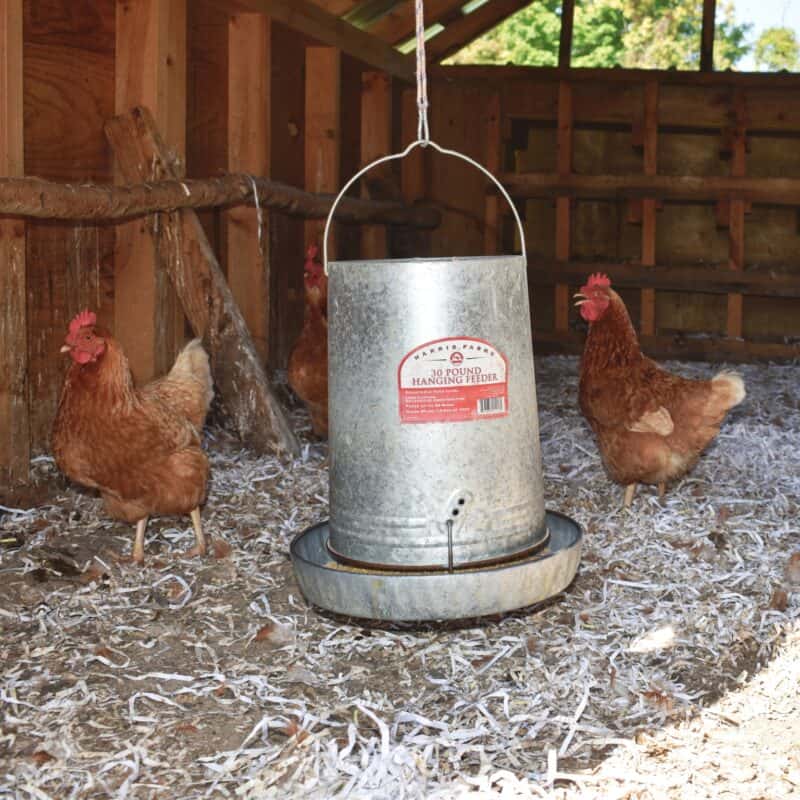
Table of Contents:
Essentials
1. The Coop
The first and most important part of chicken keeping is the coop itself, its design and construction. If the coop and run are not constructed and maintained properly the birds will not only grow really unhappy, but they will become intensely vulnerable to both disease and predator attacks.
The number and type of birds you keep in the coop and run will determine their size. I cannot recommend highly enough to invest in quality materials, and to go as large as you can even if you free range.
The more space the birds have to move, the less mess they will make waddling around in.
When the birds are continually exposed to living, walking, and eating around their own droppings, they are far more likely to develop an infection or a virus that can spread.
A severe bacterial infection or contagious disease can wipe out even a large flock in less than a single week.
When birds have a large coop and run, or spend the bulk of most day free ranging, the amount of droppings and general mess they make when experiencing times of consistent rain is far less.
Proper ventilation is also a crucial part of the coop set up. If the coop is not properly ventilated illness is far more apt to develop and spread.
Make sure any vented areas are covered with hardware cloth to prevent small predators, like mink, from climbing exterior coop walls or trees and dropping down inside the coop.
Chicken wire is great for keeping birds in but extremely poor at keeping predators out.
Two steps locks should be installed on every entry point into the chicken coop and run. Raccoons are clever predators, with most fully capable of flipping a simple flap or hook style lock and making their way inside the living and day run quarters.
2. Sun and Shade
Although the chicken coop and run need to be located in a space that receives shade or offers shade via a top on part of the run of some sort, getting adequate sunlight is also critical for coop health.
When sunlight hits the ground in the run it not only dries up the mud, it also dries out the droppings. Bacteria present in chicken (or duck) droppings is typically killed when exposed to sunlight to foster enhanced drying out.
The poultry hens also need exposure to adequate sunlight, especially during the cold months of the year, to provoke maximum egg laying.
While the birds need relief from the sun to avoid heat stroke during the summer months, they will benefit from natural light exposure and solar “coop lights” during the winter – when egg production halts or is at its lowest point.
I situated my chicken coops in the center of the barnyard and near the pond not only because of the top notch sun to shade ratio, but also to enhance bot their protection and interest.
Our farm dogs and free ranging goat herd, as well as the equine herds, all live in the same area. The large animals and their droppings help deter predators from venturing into the area.
All of the goings on as the other herds move about keeping the chickens intrigued, almost as if they are watching a television show.
The horses, pony, mini donkeys, and goats all come right up to the chicken run to visit – especially when the flock is kept in the run for the day and playing with a hanging or noisy boredom buster.
Watching a cute little chicken get nose to nose through fencing with a big old horse is equally adorable and hilarious.
3. Water
There are a host of different types of poultry waterers designed to fulfill the needs of small backyard flocks to large farm and homestead flocks.
The size and number of waterers that you need will depend on the number of poultry birds in the flock and the time of the year.
The waterers must be cleaned regularly to avoid algae and other bacteria from growing in them, and making the birds sick. A sick bird is definitely not a happy bird.
I have found, through a massive amount of trial and error, that the fountain style waterers are the most sanitary – especially if you also keep ducks in with your chickens.
The little red fountain cups are the only part of the waterer that is actually inside the coop. This type of setup up makes filling the waterer or waterers on a daily basis far easier.
These waterers should be set up on a cinder block or to in order to avoid anyy dirt, mud, or other debris from easily getting into the fountain cups.
During the winter the poultry waterers will freeze – sometimes even crack. I float salt-filled water bottles in the waterers to deter freezing as much as possible, but this practice only works until the temperatures sink down to single digits.
The winter chill and the cracking it causes is one of only two drawbacks with the plastic fountain style waterers.
When the cold weather rolls in, I typically remove the fountain waterers, and replace them with thick rubber horse feed tubs because they will not warp or crack when it gets exceptionally cold outside.
If you work away from your homestead and cannot go out to the chicken coop several times a day – up to five if the weather gets really bad, and break up the ice in a waterer, you definitely should use a rubber waterer or invest in a heated waterer that can be connected to a solar generator or to an outdoor extension cord.
The other downside to this type of plastic fountain waterer relates to the matter of routine cleaning.
Because the fountain cups are on the inside of the chicken run and the rest of the bucket is on the outside, it must be unscrewed from the inside, and removed completely to be cleaned, and then positioned back in place before water can be poured back in.
This process requires two people – one to line up the fountain cup on the inside, and a second person levels the bucket portion of the waterer on the outside.
If you set up a water catchment system on the side of your chicken coop, you won’t even need to pack buckets of water very far.
We ran a water line to my barn to lessen the manual labor aspect of this daily chore just a few years ago – the time and aggravation it saved, especially during the winter months, was enormous.
4. Feeders
While you may be tempted to use a large feeder, like a plastic tub with holes cut into it for the chickens to place their beaks, this type of setup to reduce the number of visits to the coop to feed on a weekly basis can actually make the birds sick.
When a large amount of feed is set out for the flock at a single time, it is exposed to extensive moisture and can mold or rot. Birds that eat this feed can become deathly ill, and birds that forego the bad feed can die of starvation or malnutrition.
Extra feed laying in the coop or run will also attract more rodents and predators to the chicken husbandry area.
Nothing good ever comes from increasing the number of filthy rodents and deadly predators around the chicken coop.
The daily morning feeding time gives keepers the opportunity to do a quick visual health inspection of the birds, and a security inspection of the coop and run.
Stopping a problem with illness, injury, or finding a potential entryway for a predator to get into the coop can be a life-or-death issue for your birds.
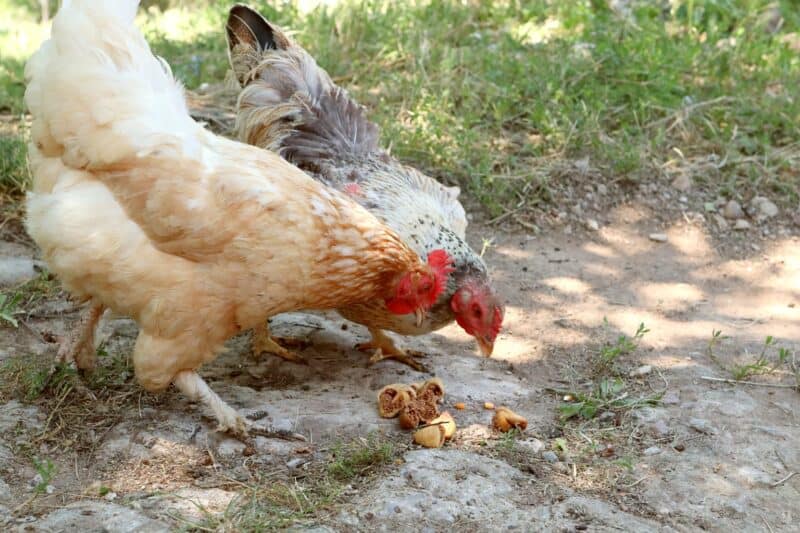
5. Healthy Snacks and Supplements
Keeping a compost pile inside the chicken coop will not only help create nutrient-rich soil for your garden, but will also provide the birds with a visually intriguing place to exercise their natural foraging skills while munching on free choice healthy snacks.
When chickens get bored they are far more likely to peck and fuss with each-other. Once blood is drawn, especially on young birds, the rest of the flock will be extremely tempted to peck and peck at the wound until the injured bird is dead.
Boredom busters like a compost pile will give the birds something to focus on besides eachpother, and fill their days with a productive activity.
You can also grow healthy snacks for the chicken flock inside or next to the chicken coop, and run for them to munch on when they free-range or when you pick a bunch and toss them inside.
Suggested vegetable and herb snacks for your chickens:
- Spinach
- Basil
- Kale
- Thyme
- Carrots
- Rosemary
- Cucumbers
- Cabbage
- Wheatgrass
- Pumpkins
Digging Boredom Busters
6. Worm Hunt
Place a mound of worm and insect filled dirt into the chicken run on a regular basis to give the flock something fresh and tasty to dig in and forage.
Both the hens and the roosters will spend hours digging into the new dirt with their feet and poking at it – and not each other or the coop walls, in search of delicious treasures to eat.
7. Dust Bath – Hens love and truly need a dust bath. The little ladies use the dust bath as a form of socialization while cleansing themselves of dust mites, and other irritating insects.
Making a dust bath involves neither a lot of time nor a lot of money. Find an old tire, plastic tub, or baby pool and fill it with loose dirt or sand.
Once the dust bath is placed inside the coop the hens will flock (pun intended) to it until it becomes either too hard or muddy from being exposed to the elements.
When this happens, simply dump the dust bath and replace it with fresh dirt or sand – or an equal parts mixture of both.
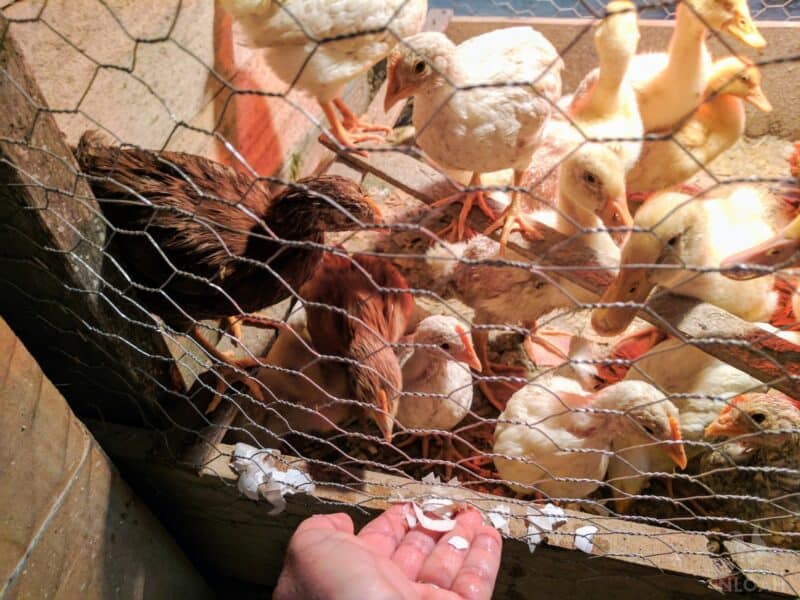
8. Grit
Caged chickens must be exposed to grit in order to process their food properly. Free-range birds will seek out grit by way of small gravel or shells, entirely on their own.
Fill a small container with oyster shells or similar grit supplements you can purchase at an agricultural supply store, and place it inside the chicken run as a free choice snack.
9. Log Hunt
Place some stumps or large pieces of firewood into the coop or run for the birds to climb upon and perch upon while they peck at the wood to discover all of the tiny little insects living inside (and munch on them for a snack).
Hanging Boredom Busters
10. Chicken Pinata – Wrap a healthy fruit or vegetable snack in twine to suspend it from the top of the chicken run to attract, intrigue, and entertain the chickens during the day.
Do not place snacks, hanging or otherwise, inside the coop itself. You want to keep the chicken laying and hatching area as clean from debris as possible to cut down on the amount of cleaning that must be done and to prevent the growth of harmful bacteria.
Apples and cabbage tend to be the two piñatas of choice with my birds.
11. Chicken Swing
Buy or make a simple swing for the birds to climb upon. Chickens, like nearly all bird species, love to be as high as possible.
The swing will give them a fresh and ever changing vantage point inside the coop and – or run, and will help keep them mentally stimulated throughout the day.
12. Jingle Bells
Spark the joys of Christmas year round by hanging some metal bells from twine, and a piece of board or tree branch. The birds will enjoy pecking at the bells causing them to make sound – until they chew the twine and you have to tie them back into place.
I like to use bells of different colors and hang them at different heights to add interest to the DIY flock musical instrument.
I typically hang this boredom buster inside the coop to keep the birds entertained when it gets so cold outside they reduce the amount of time they venture out into the chicken run.
13. Mirror
Let your pretty ladies and handsome roosters gander at themselves all day long by hanging a mirror, leting them stare at themselves, and occasionally chatter to their new pal.
14. Perches
The chicken coop will need a perch for the chickens to roost when resting during the daytime and at night. Many keepers also place a roost of some type into the run to enhance the outdoor time the birds get on a daily basis.
For a simple and cheap chicken run perch I merely put a couple of old saw horses inside, and attach a homemade swing underneath to keep the birds entertained and content.
You can also use grape vine or scrap lumber to make a jungle gym in the chicken run for the birds to climb upon, and to dart in and out of as a form of play.
15. Treat Wreath
Make a simple round wreath out of chicken wire, and fill it with healthy greens (even weeds that you cut out of the garden) and a few colorful fruit treats.
Hang the wreath inside of the chicken run for the birds to poke at throughout the day until they have cleared it all out, and it needs to be removed and refilled.
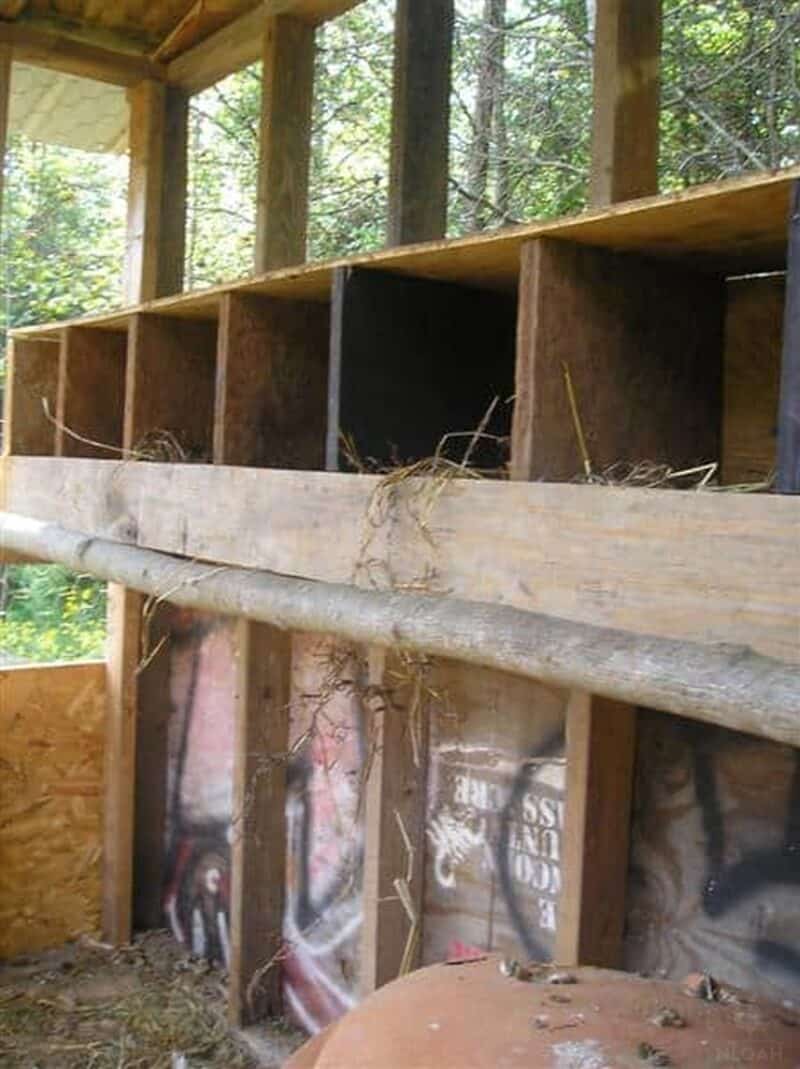
16. Nesting Boxes
Nesting boxes for the hen not only give her someplace to lay eggs, but also a secluded spot to retreat to when feeling ill or being abused by other members of the flock.
The boxes need only be simple and sturdy and filled with straw or eggs to cushion laid eggs and to help keep the hen warm during the winter.
The chicken nesting boxes should be roughly two to three feet off the ground, and easily accessible.
Sometimes, keepers install a ramp from the ground to the nesting boxes for use with breeds that are not good fliers – like my Buckeye chickens.
They never really learned to fly well, even though they spend most days free ranging and have immense freedom of movement inside of their run.
When hanging treats for the chickens to enjoy, always be mindful of the safety hazard that an ingested piece of string or rope can pose to a bird. Choking to death on a piece of string can happen.
I have had the best luck (no injuries) when using either twine or a piece of wire. I do not know the exact gauge of the wire I use every time, but it all comes from my “fix it” stash I keep next to the coop to repair an enclosure fencing stretching or similar small fixes.
Boredom Buster Snacks
17. Rolly Bottle
Poke a few dozen holes in a plastic bottle, and fill it with chicken feed or a small healthy snack. Toss the closed bottle into the run and just sit back and watch the hilarity ensue.
The chickens might be a little afraid of the plastic bottle the first time it appears, but it will not take long for them to start poking at it to reach the treat inside – rolling it all over the run for as long as an entire afternoon, until they have emptied every last morsel of food from inside.
You can also suspend the filled bottle, and use it as a hanging piñata style treat.
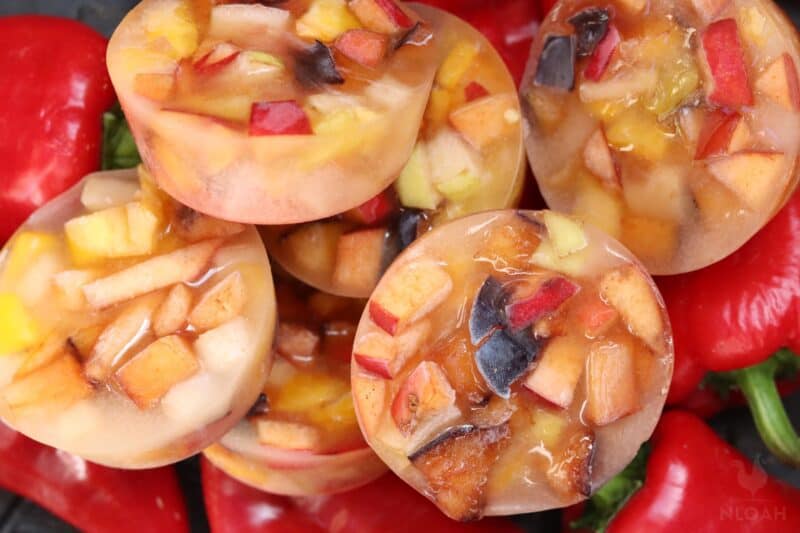
18. Frozen Fun
During the summer months, freeze a snack into ice cube trays or a mold to form a block. Once the frozen boredom buster snack is nice and solid, release it into a pan or tray, and put it in the chicken run to both give the flock a happy chore to complete by pecking it apart to reach their treat, cooling them down substantially in the process.
19. Pumpkin Patch
Cut off the top off a pumpkin, cut some holes in the side, and place it inside the chicken run. The flock will peck at this healthy snack and not at each other (or at their eggs) throughout the day until they have devoured it all.
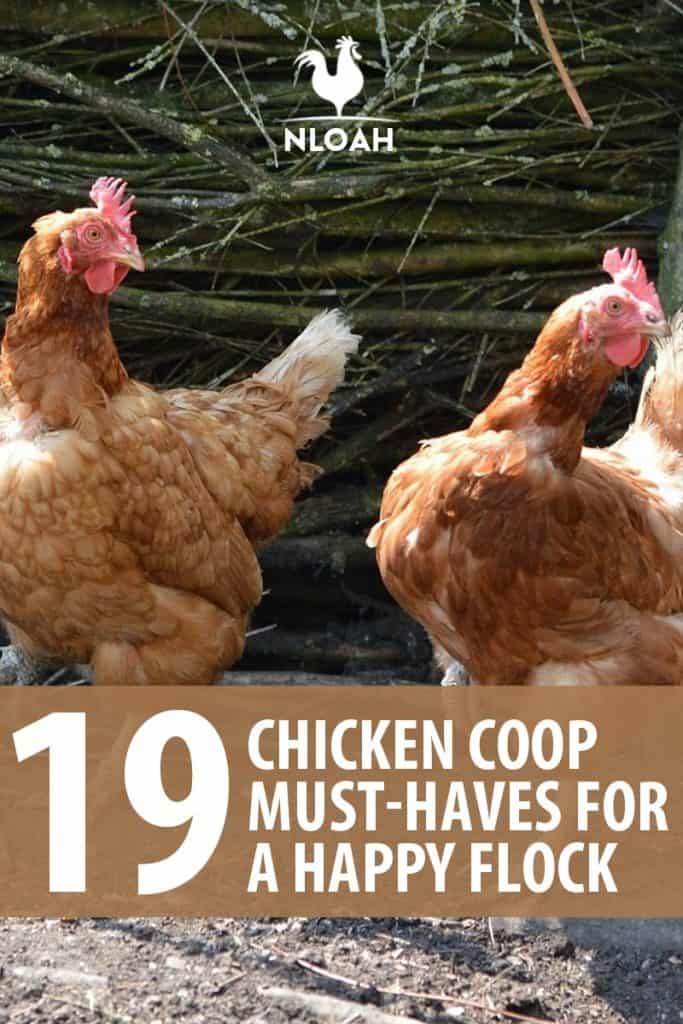

Tara lives on a 56 acres farm in the Appalachian Mountains, where she faces homesteading and farming challenges every single day, raising chickens, goats, horses, and tons of vegetables. She’s an expert in all sorts of homesteading skills such as hide tanning, doll making, tree tapping, and many more.
